12 Best SaaS Customer Onboarding Templates to Steal in 2025
Your first interaction is make-or-break. A clunky onboarding process sends new users running for the exit, killing activation rates before they ever see your product's value. The secret isn't a complex custom system—it's leveraging proven frameworks that rocket users to their "aha!" moment. Stop guessing. Start guiding.
This guide delivers 12 battle-tested SaaS customer onboarding templates you can deploy today. We're skipping the fluff and giving you a tactical breakdown of each resource, complete with screenshots, direct links, and a no-BS assessment of pros and cons. You'll learn not just what these templates are, but exactly how to use them to turn signups into power users.
We'll cover project management powerhouses like ClickUp, in-app guidance builders like Appcues, and everything in between. To see these principles in action, check out these killer SaaS onboarding examples. This isn't theory. It's an actionable playbook to fix your onboarding, boost activation, and lock in retention.
1. HubSpot
HubSpot drops a free bundle of eight editable documents to structure your customer success program. This is your foundation for standardizing manual onboarding before you buy dedicated software. The kit includes an intake form, a welcome packet, and a project timeline—all the essentials.
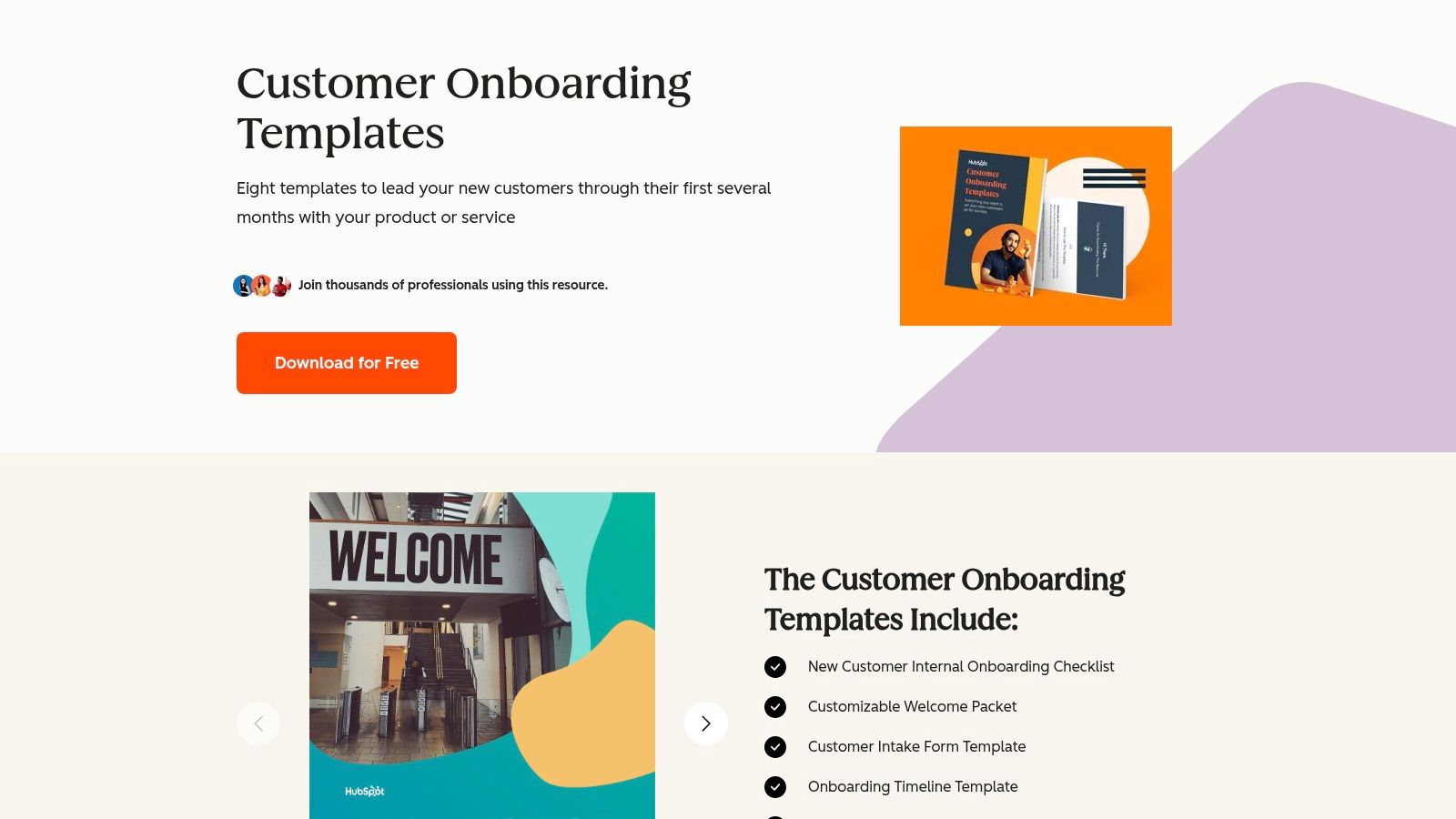
These saas customer onboarding templates are perfect for startups that need a plug-and-play starting point. They're static files (think Google Docs), giving you total flexibility but requiring manual updates to fit your workflow.
Key Features & Assessment
Actionable Insight: Use the welcome packet template immediately to standardize your new customer messaging and set expectations from day one.
Zero-Risk Start: It's a free download from a top-tier brand. Grab it to build your initial onboarding playbook without spending a dime.
The Catch: This isn't automated software. It's a set of documents to guide your team's actions, not an in-app tour for your users.
Pros | Cons |
|---|---|
Completely free to download and use. | Static files require manual updates. |
Covers multiple stages of the onboarding flow. | Not integrated with your CRM or product analytics. |
Provided by a trusted industry leader. | Lacks the dynamic nature of in-app guided tours. |
Get the templates: HubSpot Customer Onboarding Templates
2. ClickUp
If your team lives in a project management tool, this is for you. ClickUp’s customer onboarding template is a dynamic project space, not a static document. It’s pre-built to manage multiple client onboardings at once, with custom statuses and fields ready to go.
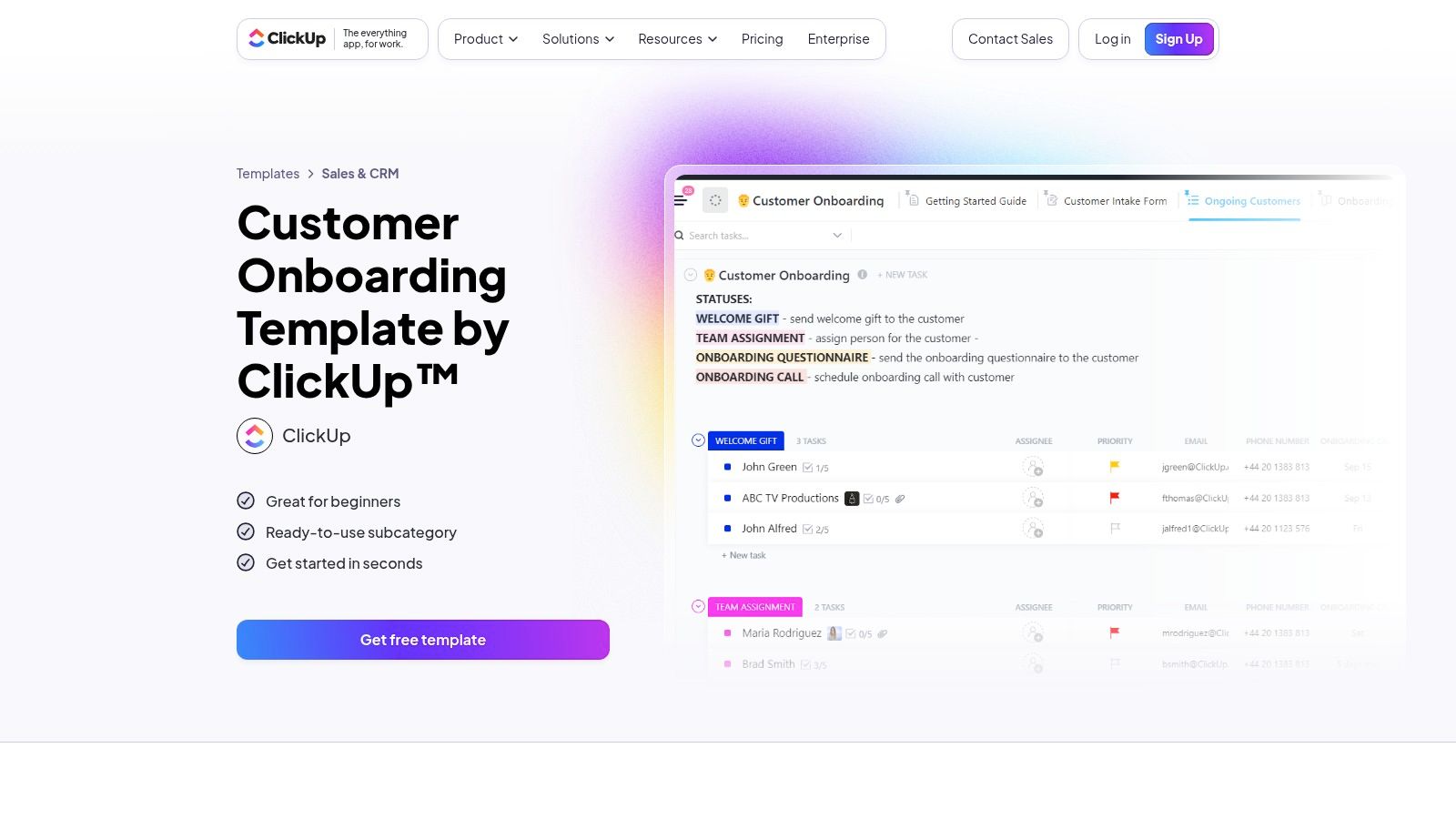
These saas customer onboarding templates create a central command center for the entire process. The template includes intake forms you can embed on your site to automatically kick off a new onboarding project. It turns your checklist into an actionable, automated workflow.
Key Features & Assessment
Actionable Insight: Connect the template's intake form to your website. New signups will instantly create a new onboarding task, assigned and ready, eliminating manual entry.
Automate Everything: Use ClickUp's native automations to assign tasks, send notifications, and update statuses. Drastically cut down your manual overhead.
The Catch: This is a ClickUp power-up. Its value is unlocked only if your team is already committed to the platform.
Pros | Cons |
|---|---|
Quick to implement for existing ClickUp users. | Requires adoption of the ClickUp platform for full benefit. |
Multiple variations available to suit different onboarding needs. | Template depth may require tailoring for complex SaaS onboarding. |
Automation and real-time collaboration features are built-in. | Can be overkill for very simple, low-touch onboarding models. |
Get the templates: ClickUp Customer Onboarding Template
3. Appcues
Appcues is all about in-app experiences. Their resources center on a template and a massive 'User Onboarding Swipe File' for building dynamic checklists, guided tours, and tooltips directly in your product—no code required. This is the blueprint for product-led growth.
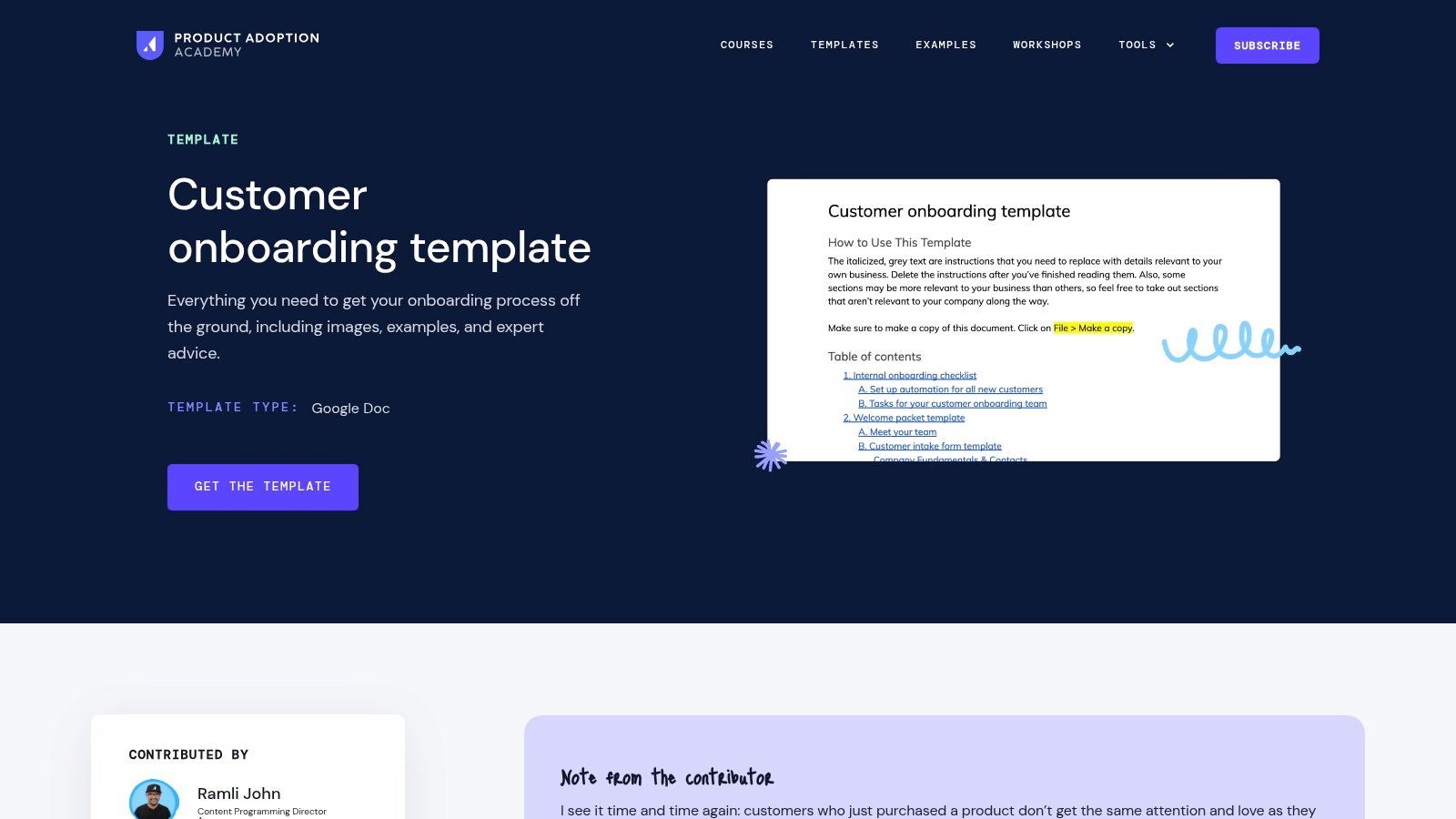
These saas customer onboarding templates ditch manual docs for automated, interactive guidance. While the swipe file is free inspiration, you need a tool like Appcues' paid platform to bring it to life. It's for teams ready to invest in software that scales user education, a cornerstone of modern user onboarding best practices.
Key Features & Assessment
Actionable Insight: Use the 'Swipe File' to find 3-5 real-world examples that match your product's feel. Steal their flow, adapt it, and build your first in-app tour.
In-App First: The focus is 100% on building modals, tooltips, and checklists inside your app, not creating external documents.
The Catch: The templates are conceptual guides. To execute, you need a paid product adoption platform and the technical setup for user segmentation.
Pros | Cons |
|---|---|
Deep onboarding expertise and practical models. | The full platform is a paid subscription service. |
Strong fit for product-led SaaS companies. | Requires event targeting for effective implementation. |
Focuses on scalable, in-app user guidance. | The templates themselves are starting points, not a full solution. |
Get the templates: Appcues Customer Onboarding Template
4. UserGuiding
UserGuiding offers a no-code platform with a library of onboarding checklist templates and interactive patterns. It’s built to help SMB and mid-market SaaS companies drive user activation inside their app. Forget static docs; this is about dynamic guides and tooltips to slash time-to-value.
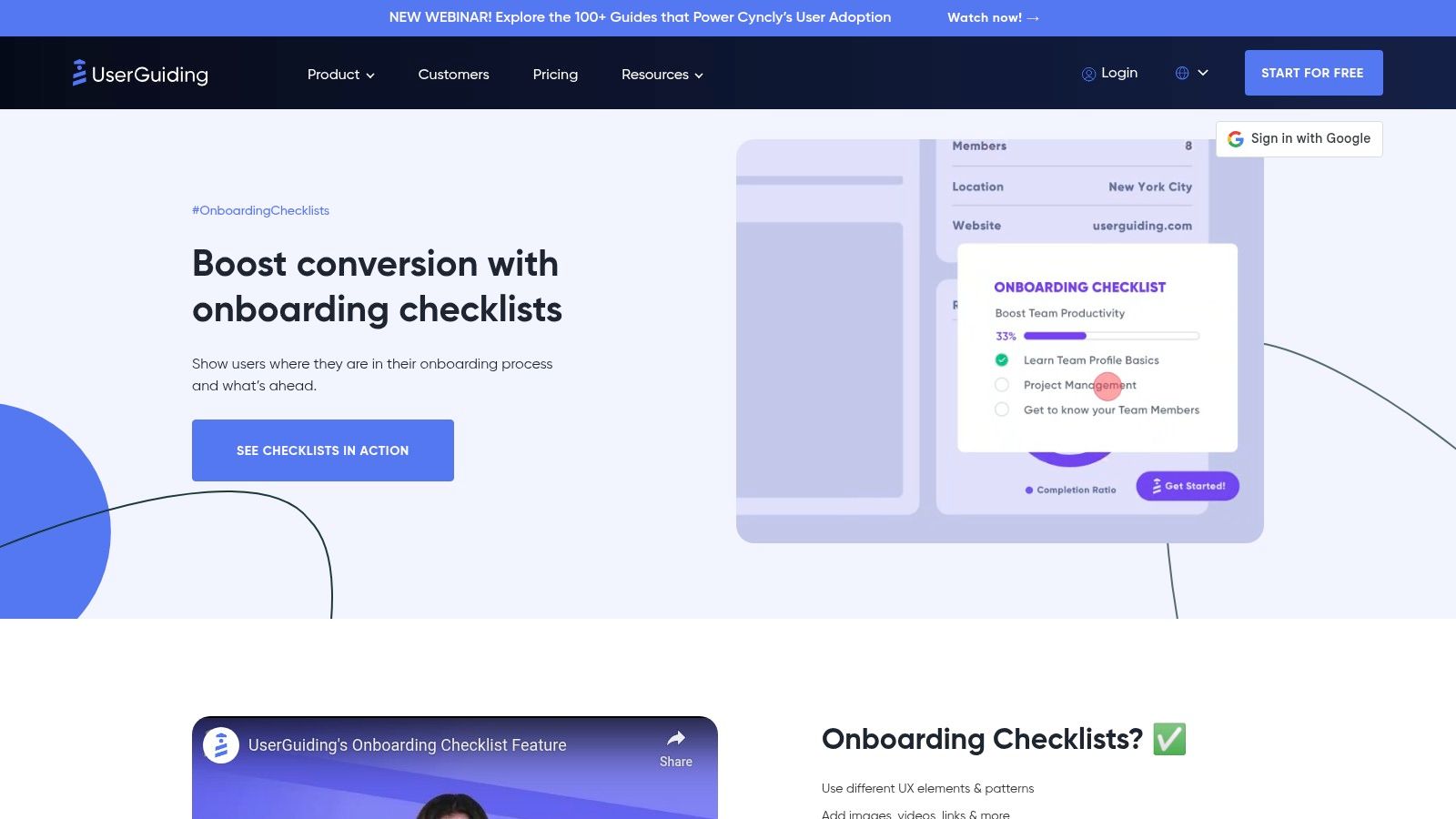
These saas customer onboarding templates are built for speed. The drag-and-drop builder lets non-technical teams create rich onboarding flows without code. It's a go-to choice for teams needing to deploy and iterate on user guidance fast to hit feature adoption goals.
Key Features & Assessment
Actionable Insight: Pick one core "activation" feature in your app. Use UserGuiding's checklist template to build a 3-step guide that forces users to engage with it on their first login.
No-Code Power: The drag-and-drop editor puts the power to build and launch onboarding flows directly into the hands of product and customer success teams.
The Catch: While great for in-product guidance, its analytics are less robust than enterprise platforms. The templates are UI-focused, not end-to-end project plans.
Pros | Cons |
|---|---|
Very fast to set up and deploy onboarding checklists. | Fewer advanced analytics compared to enterprise-grade tools. |
Well suited for small and mid-market SaaS businesses. | Templates focus on UI patterns, not end-to-end project plans. |
Enables creation of media-rich, engaging steps. | Can have a learning curve for complex segmentation rules. |
Get the templates: UserGuiding Onboarding Checklists
5. Userflow
Userflow is another no-code builder for creating dynamic in-app experiences. It provides a library of interactive flow templates—welcome modals, product tours, checklists—that you customize with a drag-and-drop editor. It’s built for teams who want to build, test, and iterate on user guidance fast.
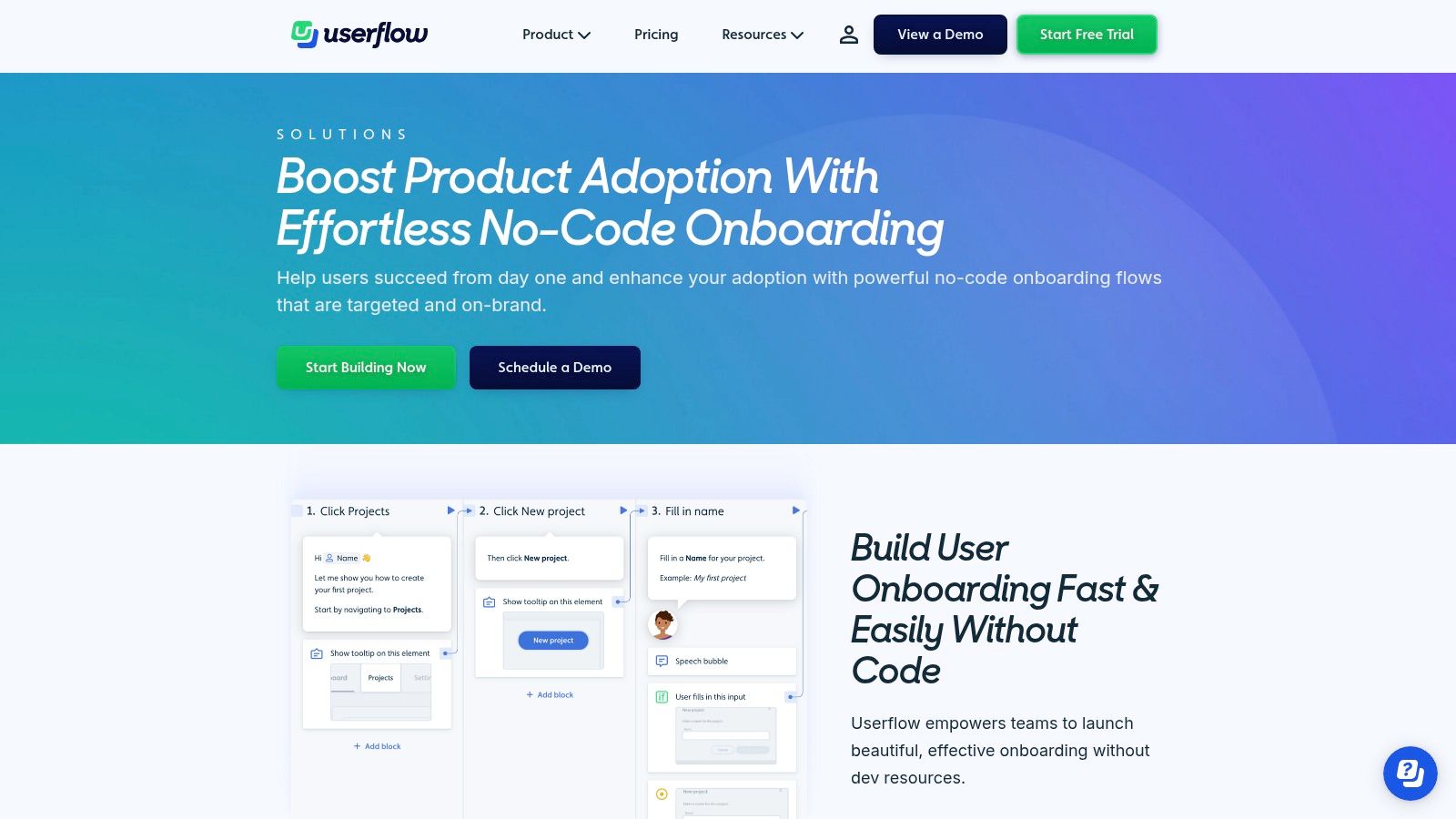
These interactive saas customer onboarding templates are a dream for product and growth teams chasing activation metrics. The platform's secret weapon is speed: preview changes instantly with a Chrome extension, no code push needed. One JavaScript snippet install is all it takes to get started.
Key Features & Assessment
Actionable Insight: Use the live preview to test two different versions of your welcome tour this week. A/B test your headline and first step to see which one gets more completions.
Rapid Iteration: The no-code builder and live preview mean you can go from idea to live test in minutes, not days.
The Catch: Templates are starting points, not finished products. You'll need to customize them for your UI. A developer is needed to install the initial script.
Pros | Cons |
|---|---|
Enables rapid creation and preview of flows. | Requires a JavaScript snippet to be installed. |
Supports complex logic like behavioral targeting. | Example templates are illustrative, not plug-and-play. |
Includes unlimited flows, checklists, and surveys. | Pricing is based on Monthly Active Users (MAUs). |
Get the templates: Userflow User Onboarding
6. Process Street
Process Street delivers a powerful library of checklist templates to systematize high-touch onboarding. It's not about in-app tours; it's about managing the complex, human-led processes happening behind the scenes. Its templates ensure flawless, repeatable workflows every single time.
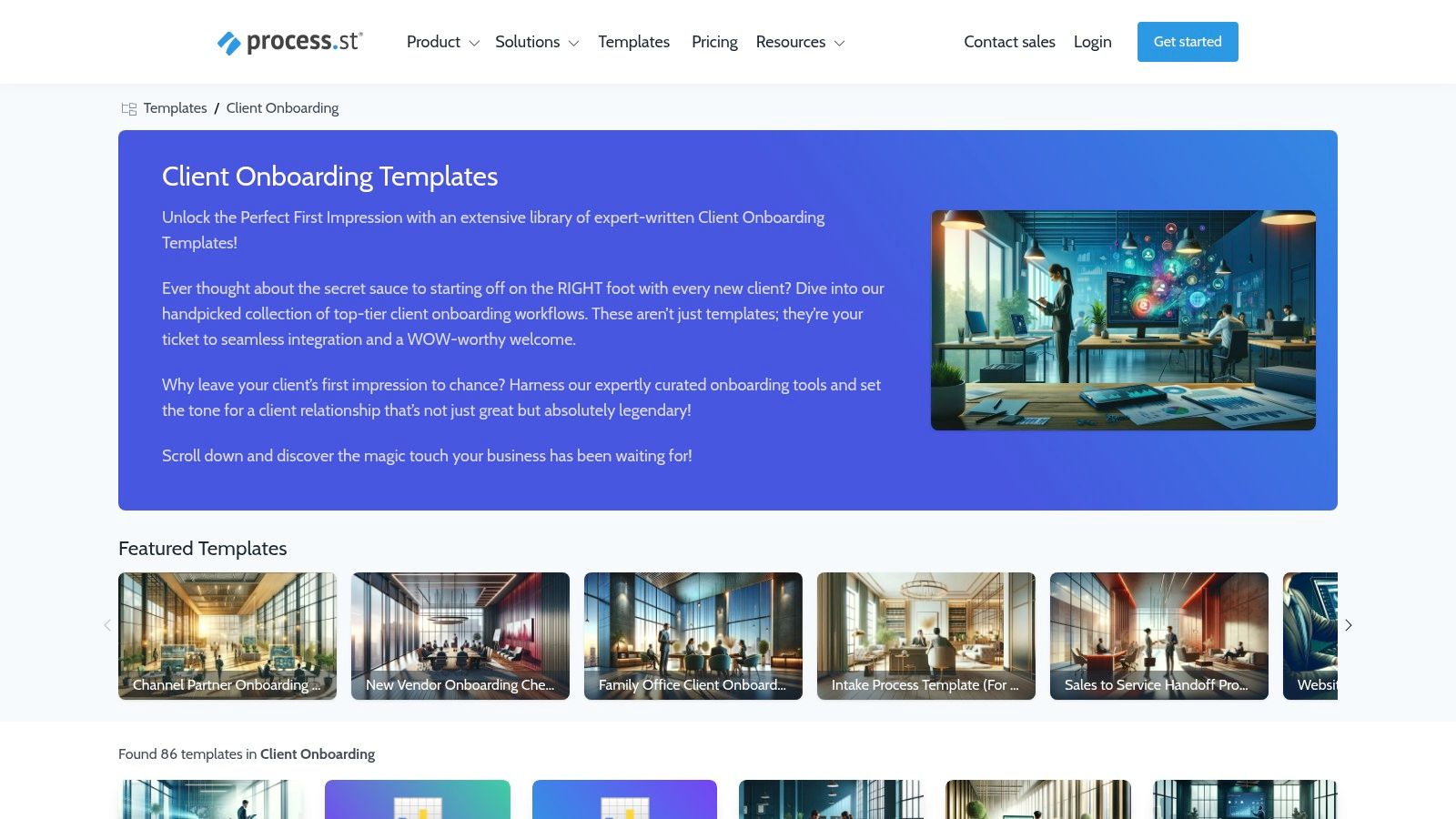
These saas customer onboarding templates are dynamic and actionable. Teams assign tasks, set deadlines, and use conditional logic to adapt the flow to customer needs. This is the perfect tool for complex B2B SaaS where onboarding requires tight coordination between implementation, success, and the client's team.
Key Features & Assessment
Actionable Insight: Implement the 'Client Implementation' template. Use conditional logic to automatically assign technical setup tasks to engineers and kickoff call tasks to CSMs based on the client's tier.
Process-Driven: This standardizes the human side of onboarding, ensuring no step is ever missed.
The Catch: It’s an internal-facing tool for your team, not an in-app guide for your user. Its full power is unlocked when you adopt it for broader business process management.
Pros | Cons |
|---|---|
Extensive library of over 80 onboarding templates. | Focuses on internal processes, not in-app user experience. |
Ideal for cross-functional implementation and success teams. | Best value is achieved when used as a full workflow tool. |
Supports conditional logic, approvals, and task assignments. | May be overly complex for simple, low-touch onboarding. |
Get the templates: Process Street Client Onboarding Templates
7. Softr
Softr offers a unique, no-code way to build dedicated customer onboarding portals. Instead of static docs, you can quickly spin up a branded, interactive hub where clients track tasks, access resources, and see their progress. It's ideal for high-touch SaaS requiring a central project space.
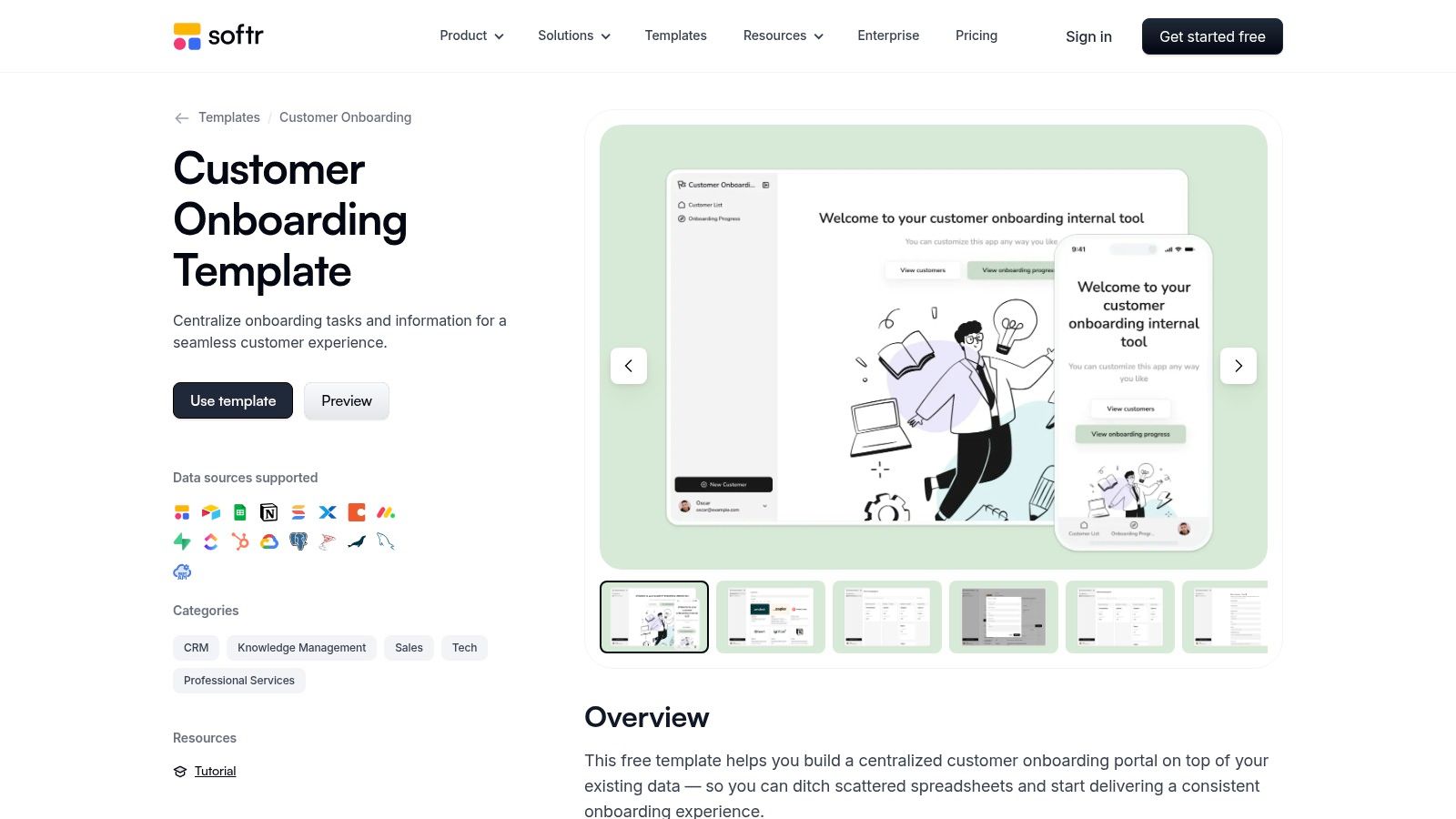
These saas customer onboarding templates are pre-built portals that hook into your data sources like Airtable or Google Sheets. This lets you manage checklists and resources from a backend you already use, giving clients a slick, custom experience without writing any code.
Key Features & Assessment
Actionable Insight: Connect a Google Sheet as your backend. Create a simple checklist for a new client and share the portal link. You now have a professional, interactive project tracker that took 15 minutes to build.
Data Integration: Connects to over 14 data sources, letting you manage progress from tools you already use.
The Catch: This creates an external portal, not in-app guidance. You're managing a separate system alongside your core product.
Pros | Cons |
|---|---|
Extremely fast deployment of a branded portal. | Portal-based, not an in-app onboarding flow. |
Free to start with flexible backend data sources. | Complex logic and full customization may require paid plans. |
Supports user roles and permission management. | Requires managing a separate system alongside your product. |
Get the templates: Softr Customer Onboarding Templates
8. Airtable
Airtable is a super-flexible database-spreadsheet hybrid that acts as a powerful backend for managing customer onboarding. Its templates let you build sophisticated workflows for tracking implementation, customer health, and account data. It’s a dynamic, collaborative command center.
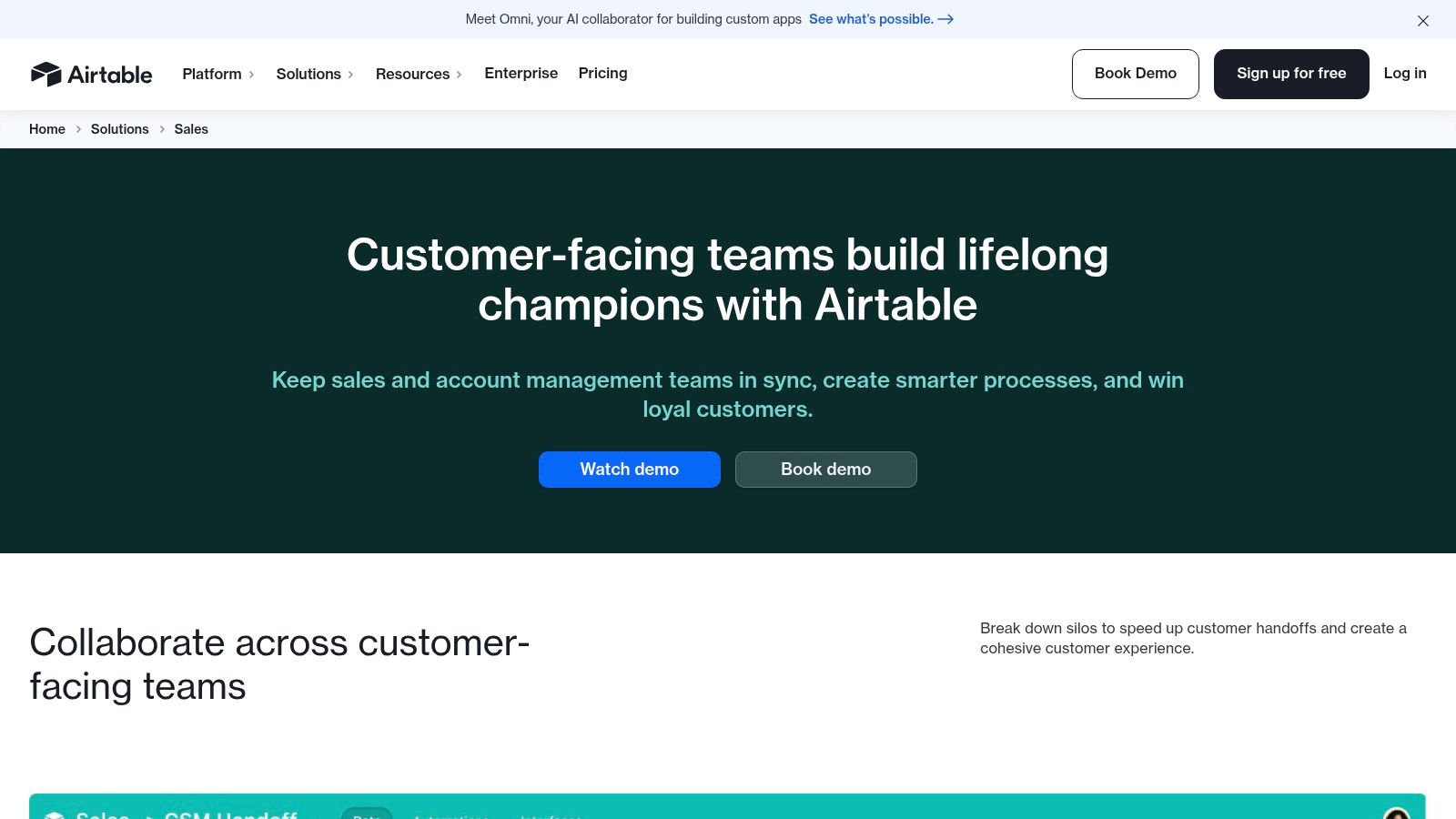
These saas customer onboarding templates are for teams who need more than a simple checklist but aren't ready for a dedicated CS platform. Airtable's superpower is automation. Connect it to Stripe to pull customer data or to Jira for technical tasks, creating a single source of truth.
Key Features & Assessment
Actionable Insight: Set up an automation. When a customer's status changes to 'Onboarding Complete' in your Airtable base, trigger a Slack notification to the #customer-success channel to celebrate the win.
Total Flexibility: Build a completely bespoke tracker with custom fields, unique views (Kanban, Gantt), and powerful data linking.
The Catch: It's a back-office system for your team, not a user-facing tool. Complex setups can have a steep learning curve.
Pros | Cons |
|---|---|
Highly flexible and adaptable to any onboarding workflow. | Not a plug-and-play in-app onboarding tool for users. |
Powerful automations and integrations with other tools. | Complex setups might require significant administrative effort. |
Scalable from a simple checklist to a complex CRM. | Can become costly as your team and data usage grows. |
Get the templates: Airtable Sales & Customer Solutions
9. Lucid (Lucidchart)
Lucid delivers visual templates for the most critical phase: planning. Instead of executable checklists, Lucidchart helps you map the entire user journey, from email sequences to in-app flows. This gets everyone on the same page before you build anything.
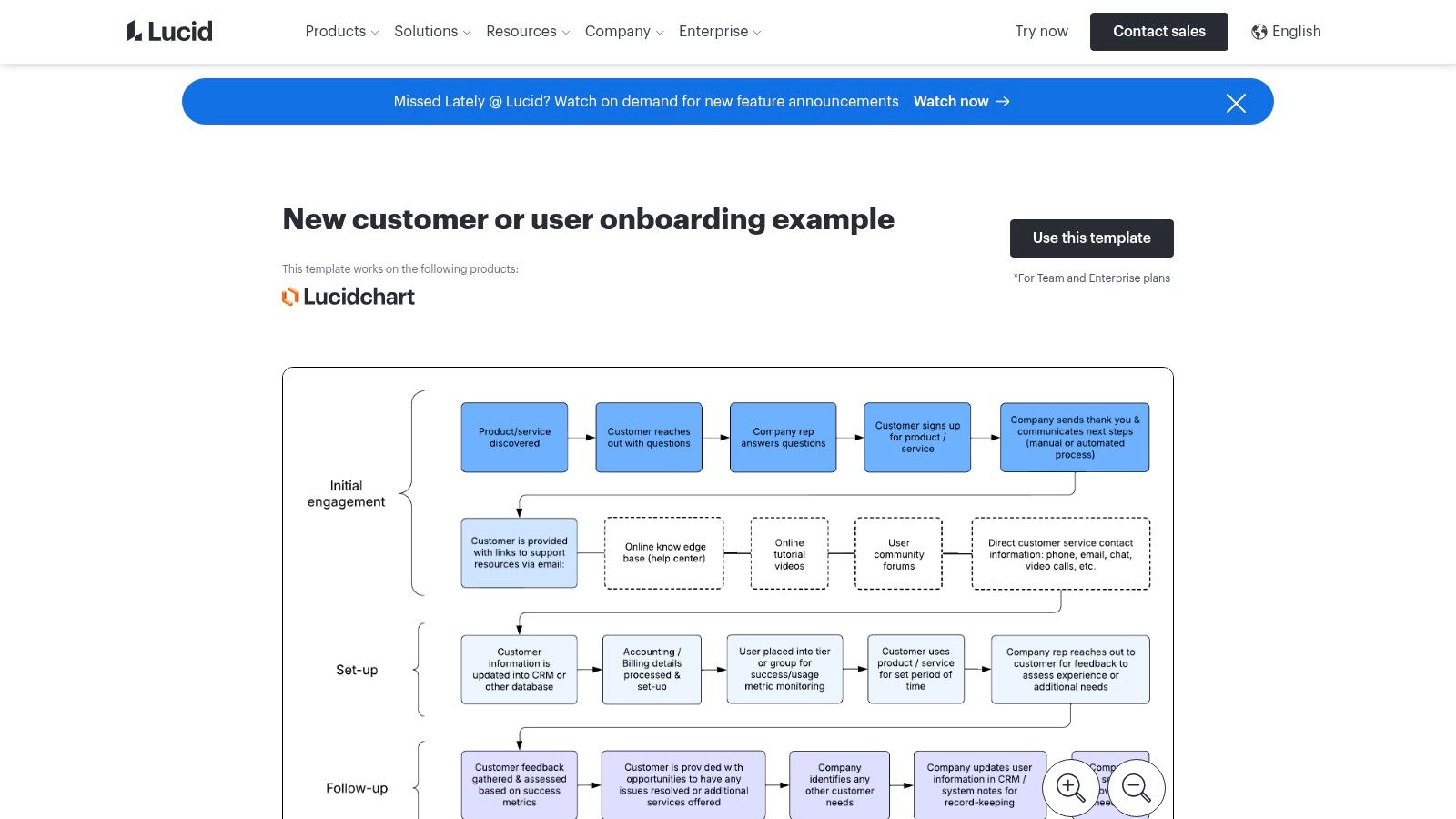
These visual saas customer onboarding templates are for product managers and CS leaders who need to align their teams. The platform's collaborative diagramming tools let you build, comment on, and refine your onboarding strategy in real-time. It’s about creating the blueprint, not the building.
Key Features & Assessment
Actionable Insight: Use the user flow template to map your current onboarding process. Invite team members to add sticky notes where users get stuck. You'll instantly spot your biggest friction points.
Strategic Planning: Perfect for high-level strategy, mapping user flows, decision trees, and communication touchpoints before execution.
The Catch: Lucid is a visualization tool, not an execution platform. You'll need other software to actually implement the flows you design.
Pros | Cons |
|---|---|
Helps teams align on onboarding journeys visually. | Focused on planning and visualization, not in-app execution. |
Fast to customize and share with stakeholders. | Some advanced templates may require a paid team plan. |
Excellent for mapping complex, multi-path flows. | Does not directly interact with users or product data. |
Get the templates: Lucidchart User Onboarding Templates
10. GUIDEcx
GUIDEcx offers a free, downloadable onboarding kit for SaaS companies managing complex implementations. While they sell a full platform, their free resources provide a structured, project-based approach to onboarding. The kit includes checklists and email templates to streamline your process.
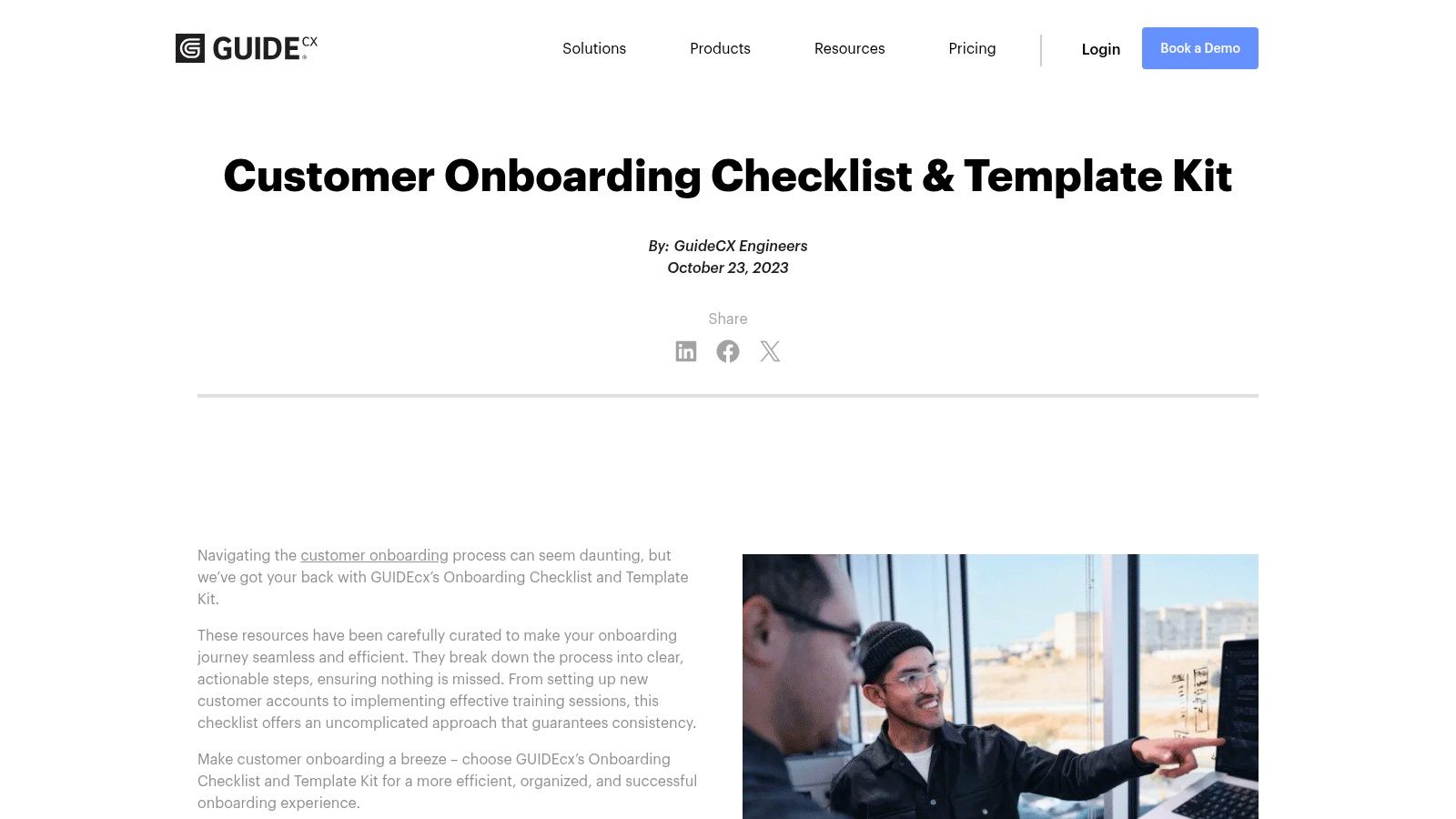
These saas customer onboarding templates are built for high-touch, multi-stakeholder projects where timelines and ownership are everything. GUIDEcx's approach is rooted in project management, which is key to reducing time-to-value. Standardizing this process creates a repeatable system that directly helps you increase customer retention.
Key Features & Assessment
Actionable Insight: Use the provided email templates to create a standardized 5-part email sequence for all new high-touch customers. Ensure consistent communication from kickoff to completion.
Project-Centric: The templates are built around project plans, dependencies, and timelines—perfect for structured SaaS implementations.
The Catch: The free resources are a gateway to their paid platform. They're a great start, but are designed to show the value of their full software.
Pros | Cons |
|---|---|
Purpose-built for SaaS implementation projects. | Best suited for teams adopting the GUIDEcx platform. |
Focuses on collaboration and accountability. | Pricing is not public and is enterprise-focused. |
Scales well with integrations and roles. | The free templates are a lead magnet for their core product. |
Get the templates: GUIDEcx Customer Onboarding Checklist & Template Kit
11. Notionland
For teams running on Notion, Notionland offers a paid, purpose-built dashboard to manage customer onboarding. This template turns Notion into a lightweight project management tool for tracking new customers, tasks, and milestones. It centralizes everything in a workspace your team already knows.
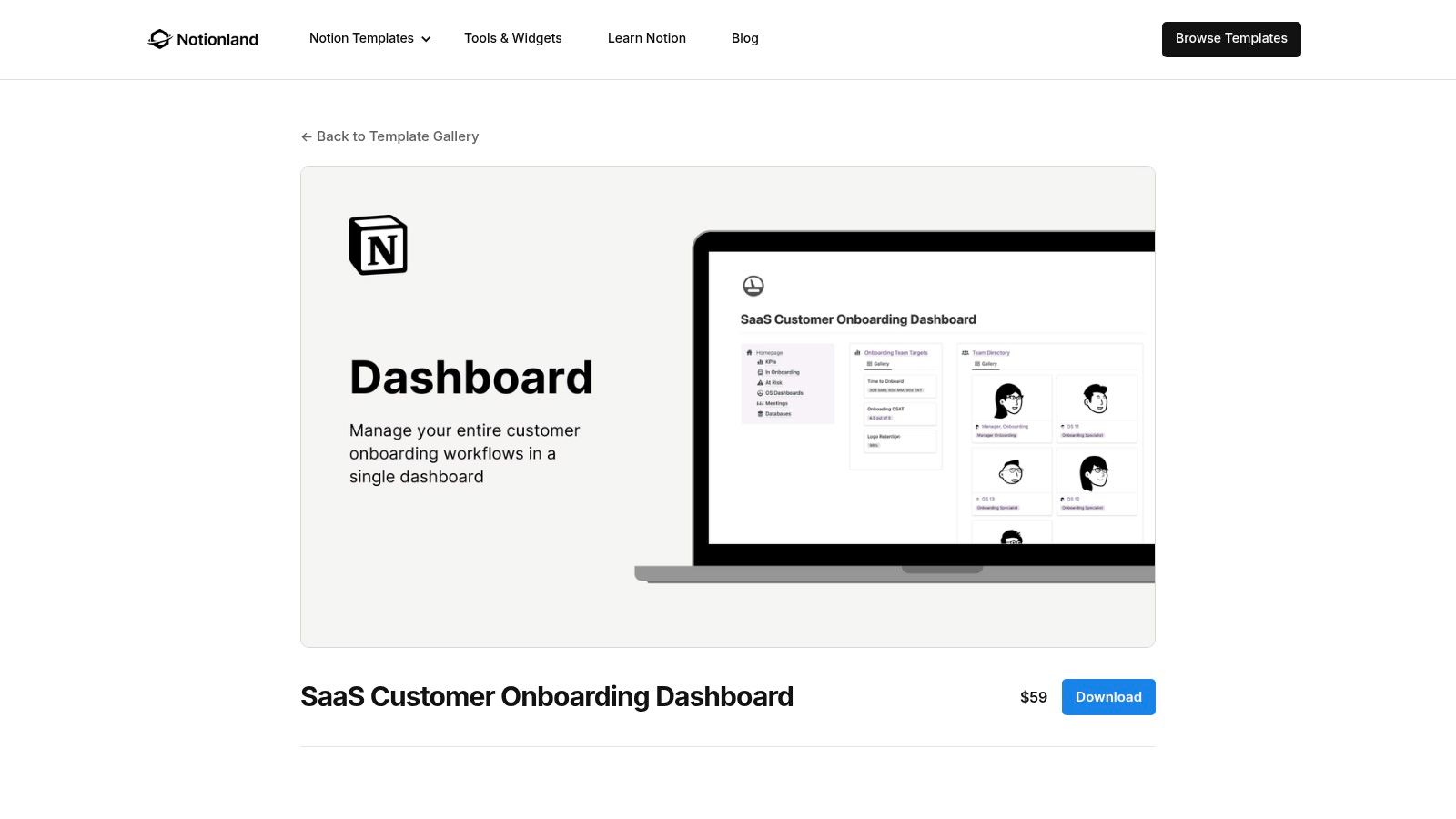
These saas customer onboarding templates are for internal team coordination, not in-app guidance. The system uses Notion databases to create a clear overview of each customer's stage, tasks, and performance. Its strength is deep customization within Notion, letting you build a process that fits your workflow perfectly without the cost of a dedicated platform.
Key Features & Assessment
Actionable Insight: Create a new view in the main dashboard filtered to show only customers with 'at-risk' status. This becomes your daily fire-fighting list for the customer success team.
Notion Native: It leverages Notion's flexibility, integrating easily with your existing company wikis and project boards.
The Catch: This is a manual, internal tool. It doesn't automate any part of the customer-facing experience like product tours or triggered emails.
Pros | Cons |
|---|---|
Affordable one-time purchase. | Not an in-app, automated onboarding solution. |
Highly customizable for teams fluent in Notion. | Relies entirely on manual data entry and updates. |
Integrates seamlessly with other Notion-based workflows. | May become difficult to manage as the company scales. |
Get the templates: Notionland SaaS Customer Onboarding Dashboard
12. TopSystems.io
TopSystems.io provides a paid Notion template to operationalize your customer onboarding process. It’s perfect for teams already using Notion as their central hub, offering a pre-built structure to track customers, manage tasks, and organize documentation without a separate tool.
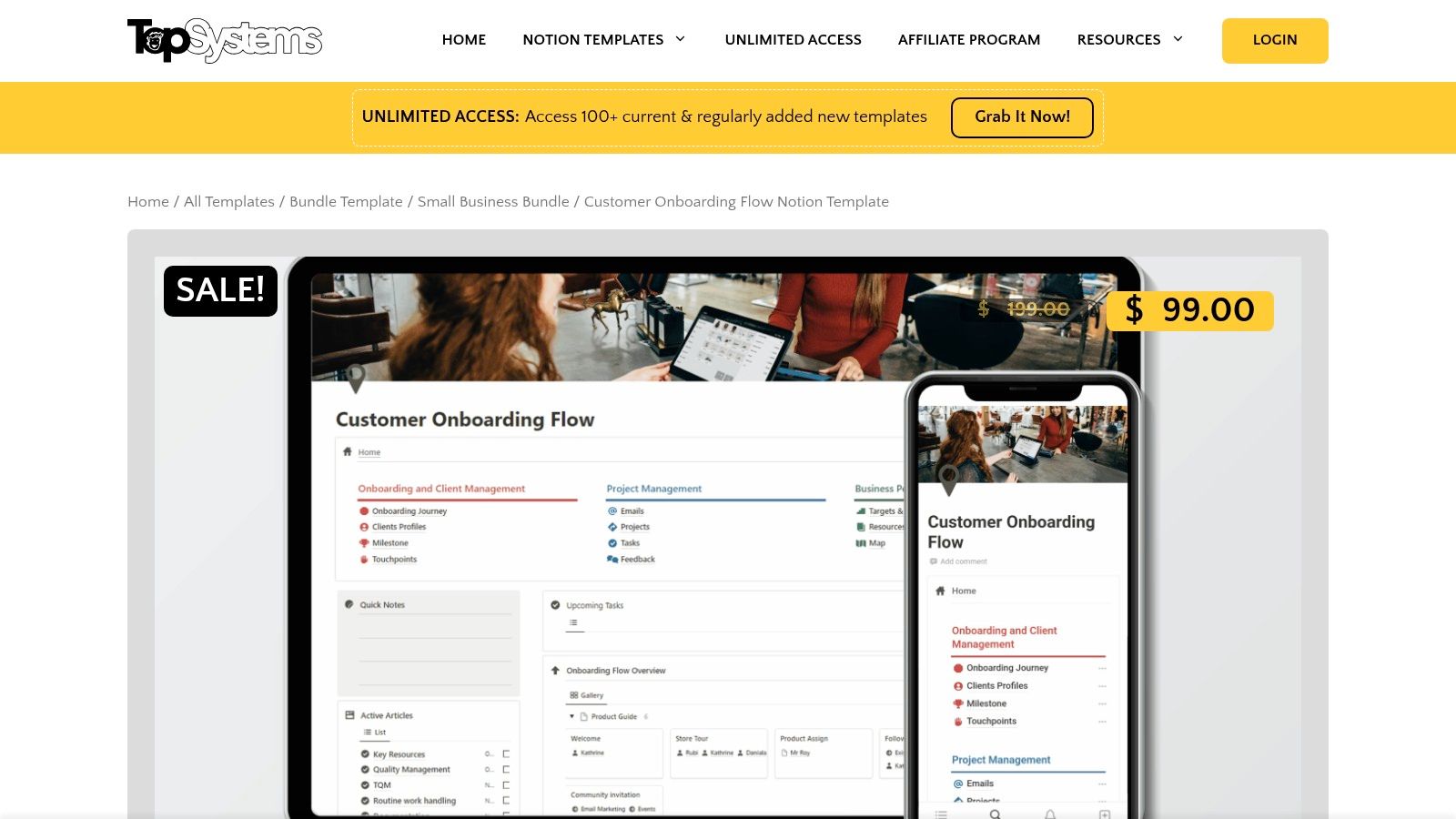
These saas customer onboarding templates are a budget-friendly alternative to specialized software, letting startups build a repeatable process from day one. By leveraging Notion's flexibility, you can easily customize the template to match your exact workflow, improving team visibility and coordination.
Key Features & Assessment
Actionable Insight: Duplicate the core onboarding flow. Modify it for a 'High-Touch Enterprise' client versus a 'Low-Touch SMB' client. You now have two distinct, repeatable processes in minutes.
Notion-Native: Built entirely within Notion, it slots directly into existing workspaces.
The Catch: It's a manual, team-facing tool. It provides no automated, interactive, or in-product onboarding for your actual users.
Pros | Cons |
|---|---|
An affordable way to structure onboarding within Notion. | Lacks detailed information on the single template vs. bundles. |
Access to a larger library of business templates is an option. | Not an interactive or in-app product onboarding solution. |
Highly customizable to fit unique company workflows. | Requires team discipline to maintain and update manually. |
Get the templates: TopSystems.io Customer Onboarding Flow Template
Customer Onboarding Templates: Top 12 Tools Comparison
Item | Core Features / Highlights | User Experience & Quality ★ | Value & Pricing 💰 | Target Audience 👥 | Unique Selling Points ✨ |
|---|---|---|---|---|---|
HubSpot | 8 editable onboarding templates, office-friendly | Free, trusted brand support ★★★★☆ | ★★★★★ Free | SaaS & services teams | Quick start with comprehensive static files |
ClickUp | In-app templates, automations, dashboards | Easy for ClickUp users ★★★★☆ | ★★★★☆ Free with ClickUp | Existing ClickUp users, PM teams | Deep ClickUp integration & custom views |
Appcues | In-app flows, checklists, no-code builder | Product-led growth focus ★★★★☆ | Paid platform, templates start | SaaS product teams | Large swipe file, no coding onboarding tours |
UserGuiding | Drag-drop checklists, media-rich steps | Fast setup, SMB focused ★★★★ | Paid plans, affordable tiers | SMB & mid-market SaaS | No-code onboarding UX patterns |
Userflow | Drag-drop builder, A/B testing, behavioral target | Fast iteration & previewing ★★★★☆ | Paid; flexible plans | SaaS product teams | Chrome preview; unlimited flows & checklists |
Process Street | 80+ checklist templates, workflow automation | Comprehensive process focus ★★★★ | Paid, best with full workflow use | Customer success & implementation | Repeatable checklists with approvals |
Softr | No-code onboarding portals, multi-source integration | Fast branded portal launch ★★★★ | Free start; paid for advanced | Implementation hubs | Kanban task tracking with 14+ data integrations |
Airtable | Customizable onboarding bases, automations | Highly flexible ★★★★ | Paid tiers; scalable | Teams of all sizes | Strong integrations; collaboration platform |
Lucidchart | Visual onboarding & process maps | Planning & alignment focused ★★★☆ | Free templates; paid team plans | Cross-functional teams | Visualize onboarding journeys & workflows |
GUIDEcx | Checklists, email templates, client portals | SaaS implementation specialist ★★★★ | Enterprise pricing; not public | SaaS implementation teams | Client-facing portals & role management |
Notionland | Dashboard & task tracking in Notion | Lightweight & customizable ★★★★ | Paid, affordable | Notion users | Native Notion flexibility for onboarding |
TopSystems.io | Notion onboarding flow template | Budget-friendly SaaS ops ★★★ | Paid, template bundles | Notion users & SMBs | Part of business-focused Notion template library |
From Template to Triumph: Your Next Move
You've just seen a powerful arsenal of saas customer onboarding templates, from high-touch project plans in GUIDEcx to interactive tours with UserGuiding. You now have a curated list of tools to turn sign-ups into fanatics. The takeaway is simple: a template isn't a magic bullet. It's a launchpad. Real value comes from how you adapt, implement, and iterate.
The line between a user who churns and one who becomes a champion is drawn in their first few interactions. Your goal isn't just to show features; it's to rocket them to their first "aha!" moment, embedding your SaaS into their workflow for good.
Making Your Selection: A Practical Framework
Don't get overwhelmed. Focus on these three factors to pick the right template:
Onboarding Style: Are you high-touch or low-touch? For complex enterprise software, grab a project-based template from GUIDEcx or ClickUp. For a self-service product, an interactive walkthrough from Appcues or Userflow will deliver a faster punch.
Technical Resources: Bootstrapped? Your dev resources are gold. No-code solutions like Softr or a simple Notionland template deliver speed and simplicity. More integrated platforms might need developer time.
Customer Journey Complexity: Map the absolute essential steps a user must take to see value. If it's five linear steps, a simple Process Street checklist is enough. If it's a branching journey, a visual map in Lucidchart will give you the clarity you need.
Implementation Is Everything
Once you've picked your tool, the real work starts. Don't just copy-paste. Inject your brand's voice, tailor steps to your specific activation milestones, and track everything. Mastering your onboarding is fundamental to achieving scalable growth through robust systems.
Your first version will be imperfect. Good. Launch, get feedback, and refine relentlessly. A great onboarding experience is a living part of your product. You have the templates. Now go turn that potential into profit.
Ready to move beyond onboarding and master the full growth playbook? The templates in this article are just one piece of the puzzle. At Viral Marketing Lab, we provide bootstrapped founders with a complete library of actionable cheat sheets, growth blueprints, and marketing frameworks designed to accelerate user acquisition and scale your SaaS without the enterprise-level budget. Explore the resources at Viral Marketing Lab and start building your growth engine today.










